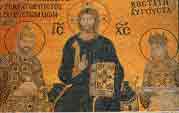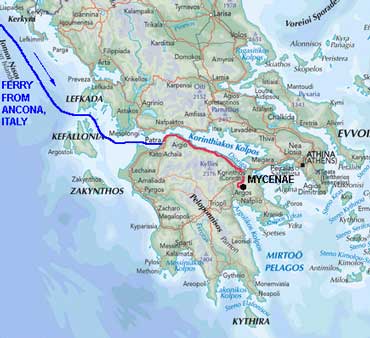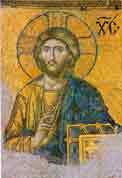 OUR GREEK ODYSSEY - Week 2
OUR GREEK ODYSSEY - Week 2
Week 2 Photos
Bottom of page
Return to Index-page
|
The campsite is in the heart of the village, and although the facilities could be described as 'somewhat straightforward', the hospitality we have enjoyed has been beyond description. Having settled in, Tuesday was spent in the Nemea area to visit the Shrine of Nemean Zeus archaeological site. The spring sunshine was refreshingly warm and we spent a blissfully peaceful couple of hours wandering among the excavations, Sheila studying the wild flora and I photographing both the temple site and the stadium. This was the venue for the Nemean Games which rivalled the other Panhellenic festivals at Olympia, Isthmia and Delphi (all to be visited later). Nemea has also from antiquity been one of the better wine-producing areas of Greece; we visited the Palivou Estate to taste and buy their wines - white from the locally grown Moschophilero grape and red from the Agiorgitiko grape. Neither are well known but could creditably take their place in world markets. Wednesday is market day in the local town of Argos, and naturally we wandered among the stalls to stock up for the coming holiday weekend. Photo 2 shows Sheila discussing the price of olives. We also wanted to re-visit the excavated remains of the spectacular Classical theatre, which is built into the limestone hillside overlooking the modern town and held 20,000 spectators. George had his first fill of Greek diesel at € 0.67 / litre (around 48p). We had planned to travel on the 3' 8" gauge Peloponnesian railway crossing the mountains to Tripoli for the day (it wasn't that we wanted to go to Tripoli - just that the railway went there!). This meant a 6-00am start, before 'Rosy Fingered Dawn' had brightened the surrounding mountains, to walk the 2kms to the local station. Unfortunately at Argos, the train has been replaced by bus service. We got our day in Tripoli, and the town's excellent Archaeological Museum more than made the trip worthwhile, but we missed out on the spectacular rail journey through the mountains. We also enjoyed an excellent L-3 (that's Barker family-speak for Long-Lazy-Lunch) at a local taverna. On Good Friday, we visited the remains of the Temple of Hera, superbly sited among olive groves on a flower-covered mountain-side near Argos. The air was filled with the scent of wild thyme and oregano, and under the trees, we met up with a passing wild tortoise. Good Friday evening is the Greek Orthodox service of Epitaphios, when a flower-bedecked bier, symbolising the crucified Christ, is carried around the village. It was truly moving to attend the service. What finer way to spend Easter Saturday than up at the archaeological site of the citadel of Mycenae, which gave its name to the early Greek Mycenaean civilisation. Dating from around 1,650 BC, the hill-top palace-fortress was the power base of kings like Agamemnon, who led the Greeks in the Trojan Wars as described in Homer's Iliad. Mighty walls surround the fortress, said to have been built by mythical giants, the Cyclops; how else could the huge stone blocks have been lifted into place? The most impressive structure is the Lion Gate guarding the approach, so-called from the carved relief of 2 lions mounted over the lintel stone which itself weighs over 20 tons (see Photo 3) - the earliest such monumental sculpture in Europe. Saturday night is the climax of Greek Orthodox Easter when at the midnight service, the darkened church is suddenly lit up with lighted candles, representing the Resurrection. Our candles were lit by neighbours and we in turn passed on the light with the words "Khristos anesti" (Christ is risen) to which the customary response is "Alithos anesti" (Truly he is risen). The church terrace was a sea of light as everyone, carrying their lighted candles, gathered outside for the Easter blessing. We all exchanged traditional Easter greetings "Chronia Polla" (Many happy returns), as fireworks cracked out across the village. Easter Day was even more special. Each family traditionally spit-roasts a lamb (seen hanging in butchers' shops all week!) to celebrate the end of the Lenten fast. We had been invited to share in the family's Easter celebratory lunch around the psistaria (spit). It was such a privilege and a totally memorable occasion - see photo 4. During the week, we have settled happily into the relaxed Greek way of life. Our language is improving and we have learnt much about Greek culture and politics: will the new government led by Costas Karamanlis succeed in rooting out corruption, and will he ensure that facilities are ready for the forthcoming Olympics? We have consistently encountered friendly and helpful courtesy from people in buses, trains and shops - the Greek word 'xenos' means both 'stranger' and 'guest'. After staying at Mycenae for 9 nights and having been welcomed as part of the family, we shall be very sad to leave. But it is time to move on to the next stage of our travels, across the Arcadian mountains to Olympia, ancient home of the Olympic Games. More of this next week. Sheila and Paul Published: Thursday 15 April
|
 Week 2 news:
Week 2 news: 